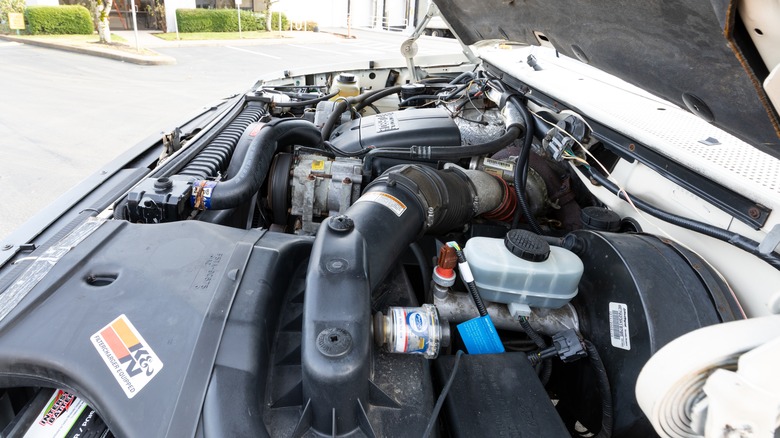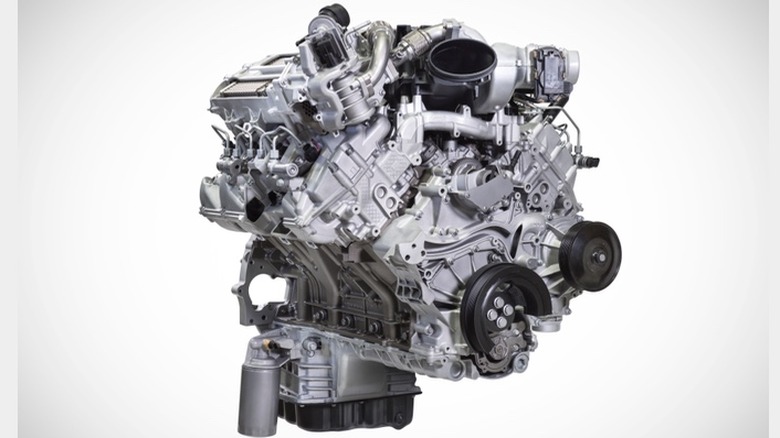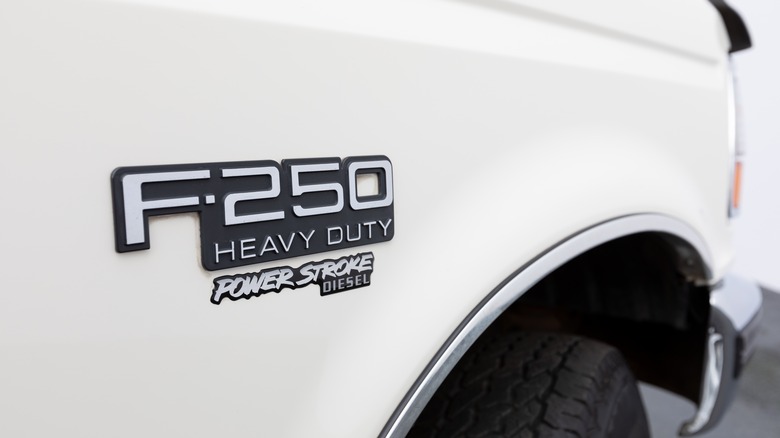Why The Navistar/Ford 7.3L Power Stroke Is One Of The Best Diesel Engines Ever Built
If you're involved in the diesel truck world, you'll know that there is a trifecta of American engine lines that have dominated the diesel market for decades. Those include the Dodge/Cummins, Chevy Duramax, and Ford Power Stroke. While the diesel Cummins beat the other two to the market, with their first offering in 1987, the Ford 7.3L Power Stroke arrived on the scene in 1994 and immediately took the stage as the engine to beat.
Interestingly enough, the 7.3L Power Stroke, which has garnered quite a bit of praise for being one of the best diesel engines ever built, wasn't an original design by Ford. Rarely receiving the recognition that they deserve for their hand in the 7.3L, Navistar International is the company that brought the famed turbo diesel to Ford, referencing their own 7.3L T444E diesel V8. Obviously, no one knew that the 7.3L would be such a tank of an engine 30 years after its release in 1994. Truck buyers did know, however, that the 7.3L made the most power of any turbo diesel engine on the market, which pushed quite a few out of the door.
To this day, the 7.3L remains a standout in the entire Ford Power Stroke lineup, with a huge number of Ford enthusiasts citing the 7.3L as not only the best turbo diesel engine found in Ford trucks but also one of the best engines ever offered by Ford, gas or diesel.
The 7.3L Power Stroke revolutionized Ford's turbo diesel V8 lineup
By the time that 1994 rolled around, Ford had already been manufacturing a 7.3L diesel V8 for over a decade. Between 1983 and 1994, the Ford/International 7.3L IDI V8 was Ford's flagship diesel in its light-duty truck line. 'IDI' stands for indirect diesel injection, which references the fact that fuel is first introduced into a pre-combustion chamber and later transferred to the cylinders during the power stroke. While the 7.3L IDI served Ford's light-duty truck line well for its 11 years in service, it had some major drawbacks, with the main being limited power. In naturally aspirated form, the IDI's peak output was a measly 185 horsepower and 358 lb-ft of torque, while the turbocharged 7.3L IDI only made 190 horsepower and 388 lb-ft of torque.
When the 7.3L Power Stroke was introduced in the F-Series Super Duty, it brought with it a number of new innovations and modernized engine technology. Most importantly, the Power Stroke ditched the indirect injection system in favor of an extremely sophisticated hydraulic electronic unit injection system. Also known as HEUI, the system uses PCM control and highly pressurized oil to actuate the electronic fuel injectors. The switch to the HEUI system not only allowed Ford to meet increasingly stricter emissions regulations approaching the new millennium, but it also helped to make the 7.3L Power Stroke the most powerful turbo diesel engine available in 1994. With the help of an upgraded turbocharger compared to the previous IDI, the HEUI 7.3L Power Stroke was capable of 210 horsepower and 425 lb-ft of torque. By the end of the 7.3L Power Stroke's production run in 2003, power was up to 275 horsepower and 525 lb-ft.
The 7.3 Power Stroke is widely known as one of the most reliable turbo diesels ever made
While the 7.3 Power Stroke is known as a fantastic engine for a number of reasons, its reliability is truly the engine's winning characteristic. Looking at figures for the nearly identical Navistar T444E on which the 7.3L Power Stroke is based, 50 percent of those engines have proven to surpass the 350,000-mile mark. The 7.3L Power Stroke falls in line with those numbers as well. A simple search of any popular Ford forum will pull up hundreds of 7.3 Power Stroke engines with over half a million miles on their odometer.
The 7.3L Power Stroke is one of the most reliable engines made by Ford for a number of reasons, but the main contributing factors are the diesel's simple construction, high-strength materials, and a lack of enough horsepower to be able to harm itself in factory form. There's no doubt that simplicity is a leading reason for the Power Stroke's longevity. The engine's overhead valve design requires only one in-block camshaft actuating two pushrods and two valves per cylinder. To make things even sturdier, the very few parts that the engine uses are built from extremely strong materials. The 7.3's block and cylinder heads are built from cast iron, the crankshaft and connecting rods are forged steel, and the pistons are made from cast aluminum.
Despite using a large and simple fixed geometry turbocharger, which also contributes to reliability, the 7.3L Power Stroke only ever made a peak of 275 horsepower and 525 lb-ft of torque. While those aren't numbers to scoff at, they don't get anywhere near what is needed to stress the engine's extremely strong internals.


